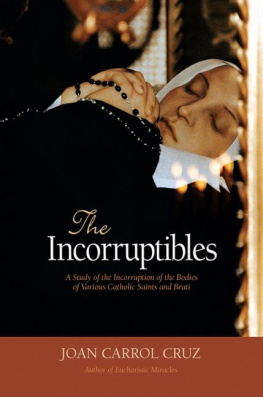Joan Carroll Cruz - Lay Saints: Models of Family Life
Here you can read online Joan Carroll Cruz - Lay Saints: Models of Family Life full text of the book (entire story) in english for free. Download pdf and epub, get meaning, cover and reviews about this ebook. year: 2015, publisher: TAN Books, genre: Non-fiction. Description of the work, (preface) as well as reviews are available. Best literature library LitArk.com created for fans of good reading and offers a wide selection of genres:
Romance novel
Science fiction
Adventure
Detective
Science
History
Home and family
Prose
Art
Politics
Computer
Non-fiction
Religion
Business
Children
Humor
Choose a favorite category and find really read worthwhile books. Enjoy immersion in the world of imagination, feel the emotions of the characters or learn something new for yourself, make an fascinating discovery.

- Book:Lay Saints: Models of Family Life
- Author:
- Publisher:TAN Books
- Genre:
- Year:2015
- Rating:4 / 5
- Favourites:Add to favourites
- Your mark:
- 80
- 1
- 2
- 3
- 4
- 5
Lay Saints: Models of Family Life: summary, description and annotation
We offer to read an annotation, description, summary or preface (depends on what the author of the book "Lay Saints: Models of Family Life" wrote himself). If you haven't found the necessary information about the book — write in the comments, we will try to find it.
Lay Saints: Models of Family Life — read online for free the complete book (whole text) full work
Below is the text of the book, divided by pages. System saving the place of the last page read, allows you to conveniently read the book "Lay Saints: Models of Family Life" online for free, without having to search again every time where you left off. Put a bookmark, and you can go to the page where you finished reading at any time.
Font size:
Interval:
Bookmark:
TAN Books
Charlotte, North Carolina
Copyright 2015 TAN Books.
Lay Saints: Models of Family Life is a selection of saints biographies originally appearing in Secular Saints 1989 by Joan Carroll Cruz. Revisions to the original biographies include updating of diction, punctuation, and spelling, along with the correction of occasional errors in typography, spelling, grammar, syntax, diction, and factual information.
All rights reserved. With the exception of short excerpts used in articles and critical review, no part of this work may be reproduced, transmitted, or stored in any form whatsoever, without the prior written permission of the publisher.
Cover design by David Ferris.
www.davidferrisdesign.com
Cover image: The Holy Family.
Cataloging-in-Publication data on file with the Library of Congress.
ISBN: 978-0-89555-722-3
Printed in the United States of America.
TAN Books
Charlotte, North Carolina
www.TANBooks.com
2015
This book is
dedicated with love
to
The Holy Family
A NATIONAL Catholic magazine polled a thousand of its readers to learn what they believe about the saints. The magazine reported that while news reports on the nations Catholics have highlighted disagreements with traditional Church teachings, sixty-seven percent of the surveys respondents said they prayed to the saints as much, or more, than they did years ago. Sixty-eight percent of the respondents said they tried to imitate the lives of the saints.
Mentioned as the four favorite saints were the Blessed Mother, St. Joseph, St. Francis of Assisi and St. Thrse of Lisieux (the Little Flower). With the exception of the Blessed Mother and St. Joseph, who are in a unique category, we are left with a Franciscan brother and a Discalced Carmelite cloistered nun. While we can admire the virtues of St. Francis and St. Thrse, the lifestyles of these two saints, and other saints of religious orders, are far removed, to say the least, from those of lay people.
Although the exact number of canonized saints is unknown, we know, of course, that the greater majority have been members of religious orders. We love them, we admire them, we wish to imitate them. But how can a mother with small children, a wife with a difficult husband, a young bride with in-law problemshow can they really relate to the nun who lived in the quiet of a cloister, the nun who lived in a community where everyone shared the work of the house? How can they relate to the saints of religious orders whose lives were arranged in an orderly manner and who had designated times for quiet prayer and who had little or no financial problems?
One might wonder whether these saints of the cloister would have merited their titles if they had remained in the world to face the conflicts and dangers confronted by ordinary lay people.
It is profitable, of course, for lay people to love these saints, to pray to them and to imitate their virtues as much as they are able. But it seems that lay people would draw more encouragement to advance in prayer and virtue and would derive more consolation in their trials by examining the troubles and temptations of those saints who lived and died as lay members of the Church.
St. Teresa of vila suggests that we need to cultivate and think upon, and seek the companionship of those saints who, though living on earth like ourselves, have accomplished such great deeds for God. In these four volumes, then, are the lives of lay saints who have, so to speak, lived on earth like ourselves. Represented here are single men and women, mothers and fathers, soldiers and servants, doctors and lawyers, the humble and the nobleall who have met the difficulties and challenges of the secular life and triumphed over them.
Their virtues are to be admired, but most of all imitated. May we benefit from their example and from their prayers.
Joan Carroll Cruz
BLESSED VIRGIN MARY
A BOOK about lay saints would be incomplete without mentioning the preeminent model for lay people, the Blessed Mother. But what could be said here that has not been mentioned about her already in numerous biographies and devotional works? We have only to delve into these to find a solicitous and understanding mother, a kindly and generous friend, a consoling companion, and a ready and willing intercessor with God.
Although it is known that Mary was free from sin, full of grace, blessed among women and the fairest honor of our race, yet she was not exempt from countless trials and hardships. She, who was the model of saints throughout the ages, should be the particular ideal of lay people, since Mary was an exemplary member of our lay ranks. She was, of course, a young bride, a young mother, a housekeeper, and a widow.
May this Immaculate Mother pray for us, that in our imitation of the saints, we can advance in virtue and eventually join her and her sainted children in our heavenly homeland.
But if it seem evil to you to serve the Lord, you have your choice: choose this day that which pleaseth you, whom you would rather serve, whether the gods which your fathers served in Mesopotamia, or the gods of the Amorrhites, in whose land you dwell: but as for me and my house we will serve the Lord.
Joshua 24:15
A S THE son of a distinguished family, Adalbald spent much of his time in the court of Dagobert I and Clovis II and may have been the Duke of Douai. An ideal Christian noble, he was a general favorite among the courtiers.
While on an expedition in Gascony, Adalbald became friends with a noble lord named Ernald, whose daughter, Rictrude, became Adalbalds bride. The wedding was performed with great pomp, but the union did not please certain members of the brides family. Yet, in spite of a critical assessment of the groom by his in-laws and their dire predictions for the couples future, the marriage proved to be a happy one. Early in their wedded life, the young couple became interested in performing works of mercy and spent time visiting the sick, relieving the poor, feeding the hungry, and converting prisoners.
Four children were born to them: a son, Mauront, and three daughters, Eusebia, Clotsind, and Adalsind. All four children imitated their parents in the ways of virtue and acts of charity.
In the year 650, sixteen years after his marriage, Adalbald was recalled to Gascony, never to return. When he reached the vicinity of Perigueux, he was attacked and killed by a number of his wifes vindictive relatives.
When news of her husbands death reached Rictrude, she was overcome with grief. Even so, she managed to obtain possession of her husbands body, which was buried with honor.
Following Adalbalds death and after her children were grown, Rictrude entered the double monastery for men and women at Marchiennes, which she had previously founded. This monastery was so arranged that the living accommodations and prayer areas were entirely separate. Only the chapel was shared, but even this was divided into sections. Accompanying Rictrude into the monastery were her two younger daughters, Adalsind and Clotsind, as well as her only son, Mauront, who left the world and the Frankish court to receive the tonsure in his mothers presence.
Following Rictrudes death, Clotsind succeeded her mother as abbess of the monastery. The third daughter, Eusebia, entered the monastery of Haimage, which had been founded by her great-grandmother, St. Gertrude of Haimage.
Font size:
Interval:
Bookmark:
Similar books «Lay Saints: Models of Family Life»
Look at similar books to Lay Saints: Models of Family Life. We have selected literature similar in name and meaning in the hope of providing readers with more options to find new, interesting, not yet read works.
Discussion, reviews of the book Lay Saints: Models of Family Life and just readers' own opinions. Leave your comments, write what you think about the work, its meaning or the main characters. Specify what exactly you liked and what you didn't like, and why you think so.




